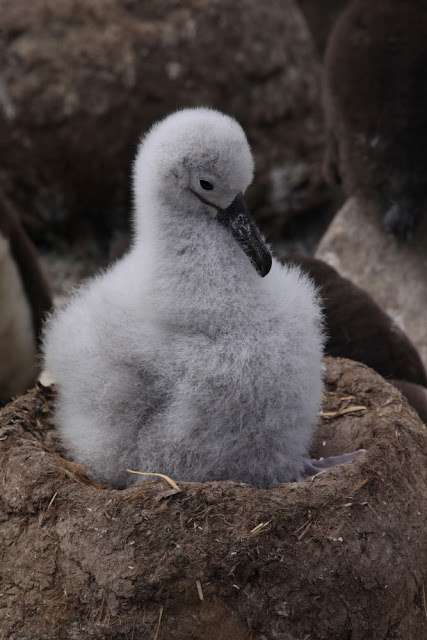I wasn't planning on writing a blog about our final stop on these two voyages, the Falkland Islands. But a request from a reader prompted me to reconsider. I'm so grateful to my readers of these postings - thank you one and all. The Falklands are an interesting set of islands but we only made two stops on this itinerary - the capital at Stanley and West Point Island.
Welcome sign on the dock in Port Stanley.
I took a tour of the Falkland battlefields with this veteran of the conflict. Here he shows the official military planning map at a strategic location west of Stanley.
The Falklands are famous for their stone runs, one of which we saw and is shown here. These were first described by Charles Darwin when he sailed here in the 1830's in the Beagle. These are peri-glacial landforms involving the freezing and thawing of permafrost during the Ice Age, which progressively brings rocks to the surface where they collect in the valley floors.
They truly are spectacular features.
Here are the ruins of an Argentine Chinook helicopter destroyed in the conflict.
The islands are largely composed of Silurian to Devonian sandstone, deposited in nearshore currents when this block of crust was located east of the South African coast. It was engulfed within the Gondwana supercontinent but then broke away and followed South America to the west.
Tumbledown Mountain where the final assault to retake Stanley took place.
War Memorial in Stanley.
Detail of the brass plaque to the conflict. Everywhere one goes in Argentina, signs proclaim "Las Malvinas son Argentina" - The islands are Argentinian.
There is definitely a British feel to the islands however.
The Anglican church with its famous whale-bone arch and summertime lupines.
Here is the dock at West Point Island where we landed by tender.
Roddy and Lillian Napier are now in their 80's and retired in Stanley. The place is being kept by caretakers and I was intrigued by the floats that are being overgrown by the gorse.
The rocks here are overgrown completely with a carpet of white lichens.
Detail of the lichens.
And a pan view of the same rock and sea cliff. This is the wild western side of West Point Island.
There are two landscapes here - a subdued upper surface composed of rolling hills and under construction for a few million years, and the steep cliff landscape being pounded by waves of the South Atlantic Ocean everyday.
Moss campion.
Note the red jackets in amongst this nesting colony of Black-browed albatross.
A mother and chick on the nest.
In flight.
They are very gentle birds and allow folks to approach quite closely.
The nest is made of compacted mud and is about two feet off the ground. Many of them have been used for decades if not centuries.
Colorful scene at the Napier's place.
Inside the house where tea is served. Lars Eric Lindblad first brought Antarctic bound tourists to this small settlement in 1967 and they are still coming. Part of his ashes are spread in the garden here. Thanks for reading this blog! Stay tuned in February for photos and stories from Death Valley.

























Thanks so much Wayne! What a fantastic trip.
ReplyDeleteI'm sure I speak for all of your loved ones, friends, and fan-readers in the blogoshere...THANK YOU Wayne for taking us all on another amazing, stupendous, fantastic adventure that only YOU can so beautifully share in words, pictures, and emotions. Thank you also to Helen for her love-filled heart, enormous support, and especially her own huge contribution . How lovely it's been to travel along in the comfort of our (mostly) warm home, becoming better and more educated people for having known you. Although we don't always speak, know that we are all there with you, every step of the way, living our dreams through you. Thank you for being you!
ReplyDeleteAbsolutely amazing journey and you tell the stories well.
ReplyDeleteJust found this blog. I'm a geo who went to NAU- so it'sneat to see you are originally from Flagstaff! Very interesting trip and great pictures!
ReplyDeleteJanelle
Professionalgeo.com